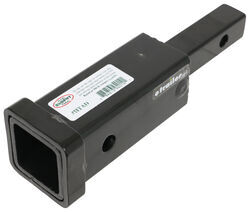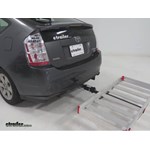
Why is HTAD Class I to Class III Trailer Hitch Adapter Not Recommended for Towing
Question:
I have seen multiple sources that say that with a Class I to Class III trailer hitch adapter one should not tow even lightweight trailers. Why is this? Im an engineer and Im not seeing why the adapter is not as good as a class I drawbar with a ball, which is the suggested method. I havent done any calculations, but the adapter uses as thick a steel as the drawbar, and the adapter has more weld area. Is it all about the change in cross section between the 1.25 bar and the 2inch square section? That would be a big, abrupt, change in stiffness. That creates a large stress concentration factor at the weld, inviting a fatigue failure. Whereas the drawbar doesnt have as big, rapid, stiffness change. Is that it, or am I overthinking it? Thank you. Phil
asked by: Phillip B
Helpful Expert Reply:
The hitch manufacturers and the manufacturers of the adapters tell us that adding an adapter between the receiver and ball mount or the receiver and a hitch mounted accessory not only increases the distance between the load and the receiver, but also introduces another piece to the system which can allow additional bouncing which increases the leverage and shock delivered to the hitch. This could apply more leverage than the hitch or its attachment points to the vehicle are designed to withstand.
An adapter like the # HTAD you mentioned is best suited for a hitch mounted accessory like a bike rack.
The best practice would be to avoid the use of a hitch adapter if at all possible, and use parts that were designed to work together.
Do folks use these for towing? I'm sure they do, but it's not a safe practice and I'd be doing the fine folks I work for and the customers we rely on a disservice if I recommended something possibly unsafe.

Product Page this Question was Asked From
Hitch Adapter 1-1/4" to 2" Trailer Hitch Receiver
- Hitch Adapters
- Hitch Expander
- Bike Racks
- Cargo Carriers
- Hitch Mounted Accessories
- 7-1/4 Inch Extension
- Fits 1-1/4 Inch Hitch
- 1-1/4 Inch to 2 Inch
- Brophy
more information >
Featured Help Information
Miscellaneous Media

Continue Researching
- Shop: Trailer Hitch
- Shop: Curt Trailer Hitch Receiver - Custom Fit - Class II - 1-1/4"
- Shop: Base Plate for Tow Bar
- Video: Brophy Hitch Adapter Review
- Shop: Hitch Adapter 1-1/4" to 2" Trailer Hitch Receiver
- Shop: Trailer Hitch Receiver Adapter 1-1/4" to 2" Hitch - 6-1/2" Long
- Shop: Trailer Hitch Adapter - 1-1/4" to 2" Hitch - 4-1/2" Drop/5" Rise - 6-1/2" L
- Q&A: 1-1/4 inch to 2 inch Hitch Adapter that Can Fit Class I Trailer Hitch
- Q&A: Is There an Adapter to Convert 1-1/4 inch Hitch to 2 inch Hitch for Cargo Carrier
- Video: Trailer Hitch Installation - 2016 Ford Fusion - Curt
- Q&A: Can I use Hitch Adapter Part # HTAD to Use a Class 3 Scooter Carrier on my 1995 Ford Taurus
- Article: Trailer Hitch Receiver Sizes
- Shop: Trailer Wiring
- Article: How to Choose the Right Trailer Hitch Class
- Shop: etrailer Trailer Hitch Receiver - Custom Fit - Matte Black Finish - Class III - 2"
- Q&A: What is the Difference Between a Class II and a Class III Hitch?
- Search Results: trailer hitch
- Video: Choosing the Right Trailer Wiring
- Shop: Vehicle Tow Bar Wiring
- Article: Brake Controller 7- and 4-Way Installation Kit (ETBC7)
- Q&A: What is the Difference Between a 4-Way and 7-Way Trailer Connector
- Search Results: hitch
- Shop: etrailer Hitch Pin Alignment Collar for Hitch Accessories - 2" Hitches
- Video: etrailer Hitch Pin Alignment Collar Review
- Article: My Trailer Hitch Doesn't Fit
- Search Results: base plates
- Shop: Curt Powered Tail Light Converter with 4-Pole Flat Trailer Connector
- Q&A: What is the Difference Between Class 1 and Class 2 Hitches for the Scion XB
- Search Results: tow bar
- Q&A: Choosing Between the Brake Buddy Select 3 and the Blue Ox Patriot Supplemental Braking System






